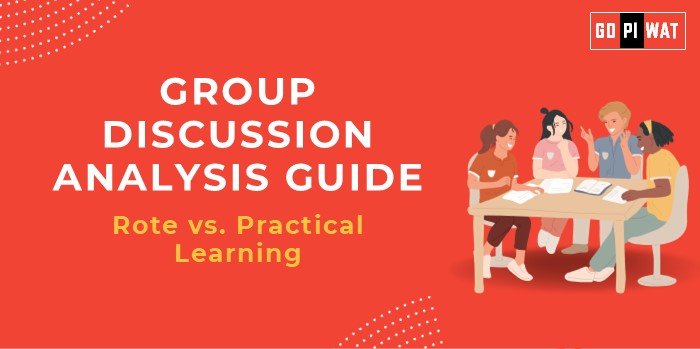📋 GD Analysis: Rote Learning vs. Practical Learning
🌐 Introduction to Rote Learning vs. Practical Learning
📖 The debate between rote learning and practical learning is central to ongoing educational reforms in India. As global demands shift towards skills-based learning, B-schools emphasize applicants equipped with problem-solving abilities and critical thinking skills.
Rote learning, relying on memorization and repetition, has long been dominant in Indian education. However, reforms like the National Education Policy (NEP) 2020 call for a shift towards experiential learning, encouraging the application of knowledge in real-world scenarios.
📊 Facts and Key Statistics
- 📜 NEP 2020 Vision: Aims to implement experiential learning across K-12 and higher education by 2030, focusing on critical thinking and problem-solving.
- 📉 Exam-Centric Impact: 76% of students feel overwhelmed by exams, and only 32% report deep conceptual understanding (National Education Survey, 2023).
- 🎓 Employability Rates: Despite 2.6 million STEM graduates annually, only 47% are considered employable due to the lack of practical skills.
- 💡 Atal Tinkering Labs: Over 10,000 labs engage 7+ million students in hands-on STEM learning and creative problem-solving.
- 🌍 Global Education Quality: India ranks 68th of 141 countries, underscoring the need for experiential learning (World Economic Forum, 2023).
🤝 Stakeholders and Their Roles
- 🏛️ Government (MHRD, NITI Aayog): Develops policies like NEP 2020 and initiatives like Atal Tinkering Labs to support practical learning.
- 🏫 Educational Institutions: Update curricula to include practical projects, labs, and experiential assignments.
- 👨👩👧👦 Parents and Students: Drive demand for skill-focused education to enhance employability.
- 🏢 Corporate Sector: Provides internships and industry projects that bridge theoretical knowledge and practical applications.
🎯 Achievements and Challenges
🌟 Achievements:
- 📜 Policy Backing: NEP 2020 mandates internships and vocational training, with over 1,000 pilot schools adopting practical curricula.
- 💡 Expansion of Atal Tinkering Labs: Over 10,000 labs promote STEM skills among 7 million+ students.
- 📚 Curriculum Reforms: IITs require internships, resulting in a 40% rise in industry-based projects at IIT Bombay (2020-2023).
- 📈 Classroom Engagement: Project-based and gamified methods improve engagement by 35% in participating schools.
⚠️ Challenges:
- 📖 Entrenched Rote Practices: High-stakes exams still prioritize memorization, slowing the transition.
- 🏚️ Infrastructure Gaps: Many schools lack resources for practical learning, especially in rural areas.
- 🎓 Teacher Training: Educators need re-training for experiential and interactive teaching methods.
🌍 Global Comparisons
- 🇫🇮 Finland: Emphasizes experiential learning, fostering creativity and problem-solving.
- 🇮🇳 India: Relies heavily on rote learning, limiting educational outcomes, but reforms show promise.
📄 Structured Arguments for Discussion
🔹 Supporting Practical Learning: “Practical learning equips students with critical thinking and problem-solving skills that rote learning cannot.”
🔹 Supporting Rote Learning: “Rote learning provides a strong foundational knowledge base essential for competitive exams.”
🔹 Balanced Perspective: “While rote learning aids foundational knowledge, integrating practical learning is crucial for real-world applications and innovation.”
📊 Effective Discussion Approaches
- 📈 Statistical Impact: “With only 47% of graduates employable, emphasizing practical learning is imperative.”
- 📚 Case Study: “Countries like Finland that focus on practical learning models show significant benefits in student creativity and engagement.”
- ⚖️ Counter-Argument Handling: Acknowledge rote learning’s role in foundational knowledge, but argue for blending it with practical methods.
💡 Strategic Analysis
Strengths:
- 🧠 Strong foundational knowledge retention.
- 📋 Efficient exam preparation.
- ⚙️ Ease of implementation in traditional setups.
Weaknesses:
- 📉 Low engagement and motivation.
- 🚫 Limited real-world application.
- 📖 Outdated teaching methods.
Opportunities:
- 🤝 Increased industry collaborations.
- 📜 NEP reforms encouraging experiential education.
- 💻 Adoption of educational technology.
Threats:
- ❌ Resistance to change among educators and policymakers.
- 🏚️ Limited infrastructure in underdeveloped areas.
- 📖 Rigid curricula focused on traditional exams.
📚 Connecting with B-School Applications
- 💼 Real-World Applications: Links to B-school projects in strategy, operations, and HR, highlighting practical learning benefits.
- 🎓 Sample Interview Questions: “How would you implement practical learning in the education system?”
- 💡 Insights: Encourages adaptability, critical thinking, and business skills essential for entrepreneurship.


